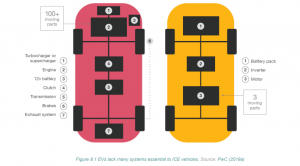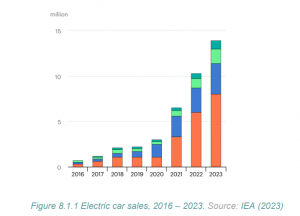Lesson 7: Electric vehicles and the automotive supply chain
In this lesson, we will explore the profound impact of electric vehicles (EVs) on the automotive supply chain. We’ll delve into how EVs differ from traditional internal combustion engine (ICE) vehicles and the challenges and opportunities this shift presents for automotive suppliers.
- Introduction
- The adoption of electric vehicles (EVs) is transforming the automotive supply chain globally.
- Although some markets are still focused on internal combustion engines (ICE), the shift to EVs is a significant trend.
- PwC analysis predicts that EVs may account for approximately 14% of global new vehicle sales in Europe and China by 2025, up from just 1% in 2017.
- This transition poses both challenges and opportunities for automotive suppliers.
- Simplification and Complexity of EVs
- EVs are mechanically simpler compared to traditional ICE vehicles.
- Electric motors in EVs have fewer components, resulting in reduced complexity.
- For example, a comparison by the UBS Group showed that an electric motor in the Chevrolet Bolt has only three moving parts, while a four-cylinder ICE engine has 113 parts.
- EVs typically have single-speed transmissions and do not require components like turbochargers or exhaust systems.

- Increased Complexity in Other Aspects
- Despite mechanical simplicity, EVs introduce complexity in other areas.
- PwC Strategy predicts that by 2025, the share of a car’s value attributed to the powertrain and electronics will rise significantly to 52%, up from 44% in 2015.
- The lithium-ion battery pack alone can account for up to 50% of an EV’s value.
- Battery production is often outside the traditional auto supply chain, creating new competition for legacy suppliers.
- Some EV battery suppliers are also venturing into electric powertrain manufacturing.
- These changes will reduce the addressable market for suppliers as EV adoption increases, with component suppliers contributing 35% to 40% of an EV’s value compared to 50% to 55% in ICE-powered cars.
- Transition from Fossil Fuels
- After a century of reliance on fossil fuels, the automotive industry faces a challenging transition to electric vehicles.
- Technological advancements and stricter emissions regulations are driving this shift.
- The transition from petrol-powered vehicles to EVs represents a significant transformation for automakers and suppliers.
- The Growth of the Electric Car Market
- Electric car markets are experiencing rapid growth, with sales surpassing 10 million units in 2022.
- The share of electric cars in total sales has tripled in three years, from 4% in 2020 to 14% in 2022.
- Sales of EVs are expected to continue strong growth through 2023, with over 2.3 million units sold in the first quarter.
- Projections suggest 14 million electric cars could be sold by the end of 2023, constituting 18% of total car sales for the year.

Conclusion
- Electric vehicles (EVs) are driving a significant transformation in the automotive industry and supply chain. They offer a simpler mechanical design but come with increased complexity in powertrain and electronics.
- Suppliers in the automotive industry must adapt to the rise of EVs by diversifying their offerings and focusing on components relevant to electric vehicles. Battery technology and electric powertrains are becoming crucial areas for innovation and competition.
- The electric car market is experiencing rapid growth, with EVs accounting for a substantial portion of total vehicle sales. Suppliers need to align their strategies with this shift to remain competitive in the evolving automotive landscape.
- While the share of value added by component suppliers in EVs may decrease compared to internal combustion engine (ICE) vehicles, there are still significant opportunities for innovation and market growth in the EV sector.
- Continued advancements in battery technology and supportive regulations are expected to further accelerate the adoption of electric vehicles, making it essential for automotive suppliers to stay agile and responsive to changing industry dynamics.
In this lesson, you’ve learned how the adoption of electric vehicles is reshaping the automotive supply chain. EVs bring both simplicity and complexity, with significant implications for suppliers and the industry as a whole. The rapid growth of the electric car market highlights the need for suppliers to adapt to these changes and seize new opportunities in the evolving automotive landscape.